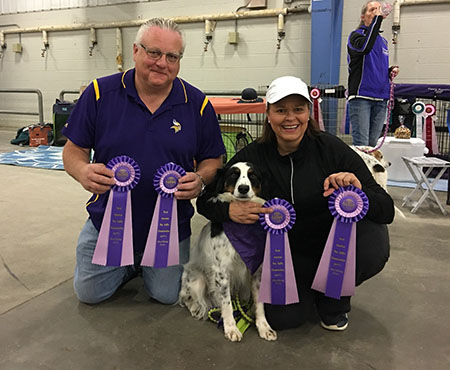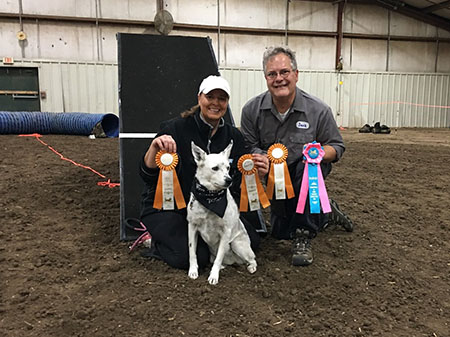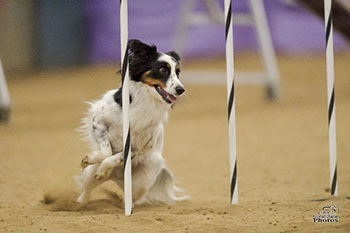
and friend David Mehlhaff, former NAFB member now with the
Kansas City Board of Utilities; Tess is Adams’ other
award-winning dog (right).
Many people consider their dogs as their best friends. But for some people like Lisa Adams, dogs are an athletic teammate, as well. Adams, who is an NAFB Allied Industry Member (Kansas City, MO), shows herding dogs on the competitive agility show circuit. Competitive canine agility is something Adams stumbled across five years ago when trying to find an exercise outlet for her white Australian cattle dog, Tess.
 “Competitive agility is one of the fastest growing dog sports in the U.S. The sport involves complex obstacle courses that test dog and handler’s athleticism and accuracy by racing against the clock. Consequently, the handler's controls are limited to voice and hand signals which requires extensive team coordination,” Adams said. She has been around dogs much of her life, growing up on a livestock farm where herding dogs were used routinely to work cattle. “Transitioning from working dog principles to competitive show ring principles has been a new and welcomed challenge,” she added. According to Adams, the sport of agility is constantly evolving, with owner and dog teams having to train continuously to advance from beginner to elite levels for national point accumulation.
“Competitive agility is one of the fastest growing dog sports in the U.S. The sport involves complex obstacle courses that test dog and handler’s athleticism and accuracy by racing against the clock. Consequently, the handler's controls are limited to voice and hand signals which requires extensive team coordination,” Adams said. She has been around dogs much of her life, growing up on a livestock farm where herding dogs were used routinely to work cattle. “Transitioning from working dog principles to competitive show ring principles has been a new and welcomed challenge,” she added. According to Adams, the sport of agility is constantly evolving, with owner and dog teams having to train continuously to advance from beginner to elite levels for national point accumulation.  “I love the sport,” smiled Adams. “It’s a game of strategy where the handler has to initiate precision-based commands to maneuver a dog traveling at lightning fast speeds while compensating for instinctive strengths and weaknesses.” Dogs jump bars, sprint through tunnels, weave through a series of poles, and climb different combinations of tower structures. While speed is important, Adams said the fastest dogs don’t necessarily win if they get lost on the course or botch an obstacle and get hit with a time penalty. “I’m still really new to the sport,” said Adams, who qualified with her newest running partner, Jaxon, a Border Collie/Australian shepherd mix, for the 2018 North American Dog Agility Council (NADAC) National Championship Show
“I love the sport,” smiled Adams. “It’s a game of strategy where the handler has to initiate precision-based commands to maneuver a dog traveling at lightning fast speeds while compensating for instinctive strengths and weaknesses.” Dogs jump bars, sprint through tunnels, weave through a series of poles, and climb different combinations of tower structures. While speed is important, Adams said the fastest dogs don’t necessarily win if they get lost on the course or botch an obstacle and get hit with a time penalty. “I’m still really new to the sport,” said Adams, who qualified with her newest running partner, Jaxon, a Border Collie/Australian shepherd mix, for the 2018 North American Dog Agility Council (NADAC) National Championship Show  Gillette, WY. A first-time national event contender, Adams and
Gillette, WY. A first-time national event contender, Adams and  Jaxon competed with 336 dogs for the chance of winning top honors in their sport in September. Adams says she was more than thrilled with her dog’s first-time performance at this year’s championship, placing 21st out of 65 dogs in their designated class category. “We worked hard to qualify, and I’m happy Jaxon finished right up there with the best,” she said. According to Adams, the NADAC Championship Show is one of the most prestigious in North America. “Jaxon’s ability to qualify with only 18 months of training was pretty amazing. This dog has speed, jumping ability, and intelligence on his side, plus an instinctive ability to elevate his game every time he enters the ring,” Adams noted. “I've been fortunate to have two dogs that embrace the sport, along with coaching from experienced trainers and clinicians.” Both of Adams’ dogs (Tess and Jaxon) are heart-wrenching, classic stories of rags to riches. “Our journey to the show pen has had its fair share of challenges,” she said, “especially when it comes to maintaining both dogs’ physical and emotional well-beings.” Unlike many of her competitors who show animals bred for canine sports, Adams’ dogs come from adoption cases out of Kansas and Oklahoma rescue programs. “While there’s lots of love and happiness to be gained by rescuing and fostering animals, it comes with some heartbreak as well,” she said. “Healing and happiness are the primary objectives for why I choose to adopt over buying purebred sporting dogs. It’s an entirely different mindset, but my dogs are an inspiration for ‘what’s possible’ when adopting animals that come from abusive backgrounds.” Adams also credits her dogs’ accomplishments to a long list of veterinarians and animal wellness experts. “Jaxon came to us with a lot of physical ailments which required surgeries and therapy to help him re-
Jaxon competed with 336 dogs for the chance of winning top honors in their sport in September. Adams says she was more than thrilled with her dog’s first-time performance at this year’s championship, placing 21st out of 65 dogs in their designated class category. “We worked hard to qualify, and I’m happy Jaxon finished right up there with the best,” she said. According to Adams, the NADAC Championship Show is one of the most prestigious in North America. “Jaxon’s ability to qualify with only 18 months of training was pretty amazing. This dog has speed, jumping ability, and intelligence on his side, plus an instinctive ability to elevate his game every time he enters the ring,” Adams noted. “I've been fortunate to have two dogs that embrace the sport, along with coaching from experienced trainers and clinicians.” Both of Adams’ dogs (Tess and Jaxon) are heart-wrenching, classic stories of rags to riches. “Our journey to the show pen has had its fair share of challenges,” she said, “especially when it comes to maintaining both dogs’ physical and emotional well-beings.” Unlike many of her competitors who show animals bred for canine sports, Adams’ dogs come from adoption cases out of Kansas and Oklahoma rescue programs. “While there’s lots of love and happiness to be gained by rescuing and fostering animals, it comes with some heartbreak as well,” she said. “Healing and happiness are the primary objectives for why I choose to adopt over buying purebred sporting dogs. It’s an entirely different mindset, but my dogs are an inspiration for ‘what’s possible’ when adopting animals that come from abusive backgrounds.” Adams also credits her dogs’ accomplishments to a long list of veterinarians and animal wellness experts. “Jaxon came to us with a lot of physical ailments which required surgeries and therapy to help him re-  learn the art of running,” she said. “We never intended to transition Jaxon to the show pen, but to use agility as a part of his physical therapy.” Surprisingly, Jaxon’s long road through recovery paid off with his veterinarian team giving their stamp of approval for him to try competitive dog sports once fully recovered. “Today, Jaxon maintains a stringent diet and exercise routine with constant vet checks and chiropractic treatments to keep him happy and healthy,” she adds. Adams travels to about 20 NADAC qualifying shows a year across the Midwest. "My dogs don't view this as work, they view it as play," she said. "But, just like any sport, there’s a lot of commitment and training that goes into it." The best part of it, she said, has nothing to do with the trophies and accolades. Showing competitive agility has brought her closer to her dogs and introduced her to many new friends in the sport. "We're having a great time,” said Adams, “and we plan to keep playing the game to see where this amazing journey takes us."
learn the art of running,” she said. “We never intended to transition Jaxon to the show pen, but to use agility as a part of his physical therapy.” Surprisingly, Jaxon’s long road through recovery paid off with his veterinarian team giving their stamp of approval for him to try competitive dog sports once fully recovered. “Today, Jaxon maintains a stringent diet and exercise routine with constant vet checks and chiropractic treatments to keep him happy and healthy,” she adds. Adams travels to about 20 NADAC qualifying shows a year across the Midwest. "My dogs don't view this as work, they view it as play," she said. "But, just like any sport, there’s a lot of commitment and training that goes into it." The best part of it, she said, has nothing to do with the trophies and accolades. Showing competitive agility has brought her closer to her dogs and introduced her to many new friends in the sport. "We're having a great time,” said Adams, “and we plan to keep playing the game to see where this amazing journey takes us."
